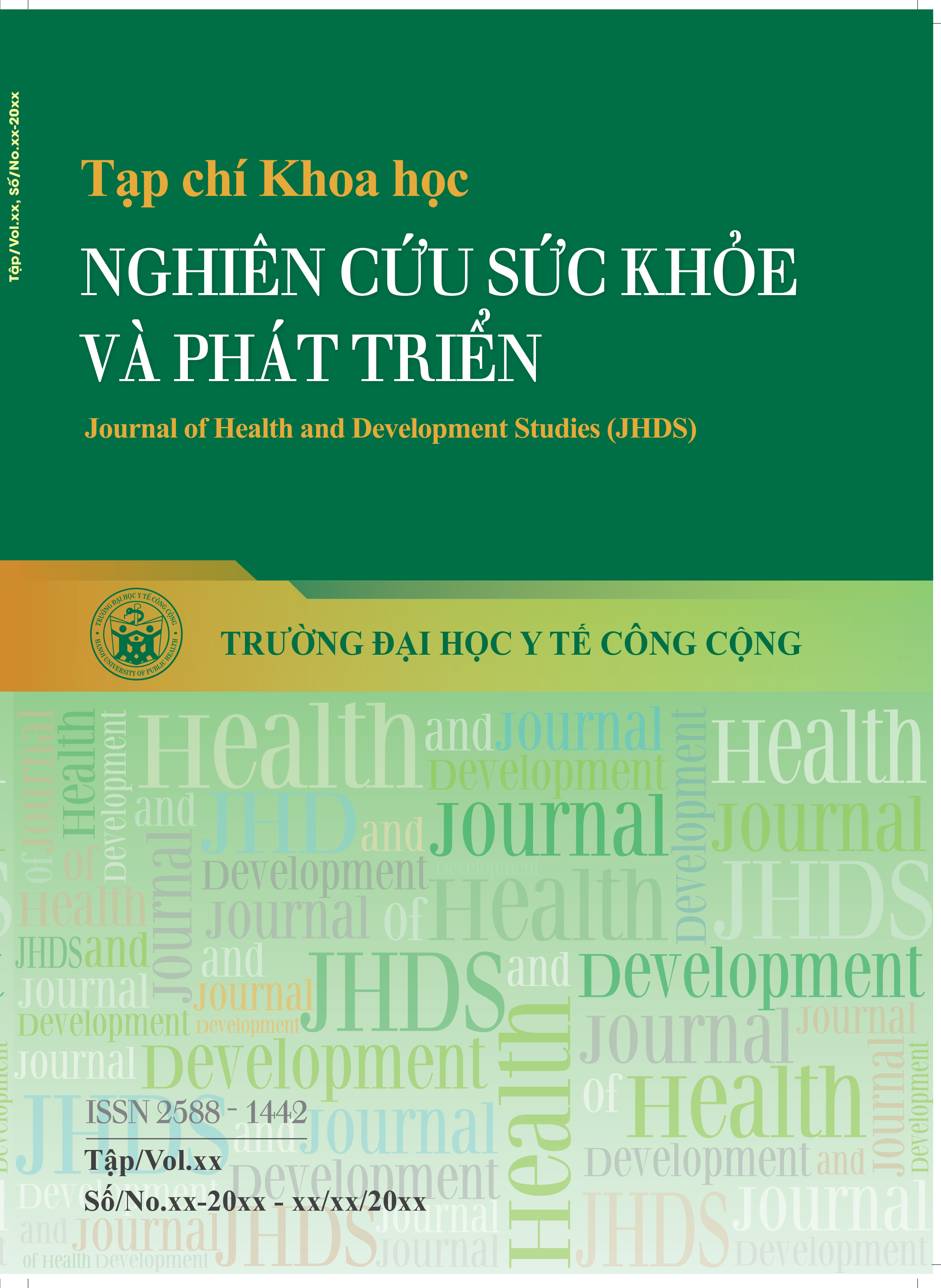Tạp chí
Khoa học Nghiên cứu Sức khỏe và Phát triển
(Journal of Health and Development Studies – JHDS)
Trường Đại học Y tế công cộng
ISSN (Print): 2588-1442
ISSN (Online): XXXX-XXXX
https://jhds.edu.vn
Cost – effectiveness analysis of hyaluronic acid injection relative to oral medication for knee osteoarthritis treatment at Nguyen Trai hospital in the period of 2022 – 2023
- Mã bài báo : SKPT_24_004
- Ngày xuất bản : 29/02/2024
- Số trang : 104-114
- Tác giả : Nguyen Quoc Tuan
- Lượt xem : ( 534 )
Danh sách tác giả (*)
- Nguyen Quoc Tuan 1 - Nguyen Trai Hospital, Ho Chi Minh City, Vietnam
- Quach Thanh Hung 1 - Viet Nam University of Traditional Medicine
- Pham Chau Thanh Phuong 2 - Nguyen Trai Hospital, Ho Chi Minh City, Vietnam
- Nguyen Hoang Huynh Van 3 - Department of Pharmaceutical Administration, University of Medicine and Pharmacy at Ho Chi Minh City, Ho Chi Minh City, Vietnam
- Ngo Le Lan Uyen 4 - Department of Pharmaceutical Administration, University of Medicine and Pharmacy at Ho Chi Minh City, Ho Chi Minh City, Vietnam
- Pham Vo Kieu Thu - Department of Pharmaceutical Administration, University of Medicine and Pharmacy at Ho Chi Minh City, Ho Chi Minh City, Vietnam
- Nguyen Vo Thu Hien - Nguyen Trai Hospital, Ho Chi Minh City, Vietnam
- Pham Dinh Luyen - Department of Pharmaceutical Administration, University of Medicine and Pharmacy at Ho Chi Minh City, Ho Chi Minh City, Vietnam
Objective Pharmacological treatments, primarily oral NSAIDs, constituted 73.9% usage for knee osteoarthritis. Despite the known adverse effects of NSAIDs, they are recommended for KOA management. Hyaluronic acid injections, an emerging alternative, lack consensus and evidence of cost-effectiveness in Vietnam. This study aimed to analyze the cost-effectiveness of hyaluronic acid injections relative to oral medication treatment in patients with KOA from health insurance payer’s perspective.
Methods: A retrospective study was conducted using electronic medical records of KOA patients from March 1, 2022, to May 31, 2023, at Nguyen Trai Hospital to analyze costs. A cross-sectional descriptive study of two groups receiving hyaluronic acid injections (HA) or oral medication treatment (PO) was conducted using the WOMAC scale converted to EQ-5D-5L to measure treatment effectiveness in QALYs. Seemingly unrelated regression equation was utilized to estimate the Incremental Cost-effectiveness Ratio (ICER) of HA relative to PO while simutaneously adjusting for other confounding factors.
Results: The PO group exhibited a higher total WOMAC score than the HA group (PO group: 45.12; HA group: 44.29), indicating greater severity in the WOMAC Pain, Function, and Stiffness categories. The QALYs of HA group was higher than those of the PO group, with QALYs values of 0,719 and 0,661, respectively. The total medical direct costs increased by 6.232.445 VND, and QALYs increased by 0,041 when using HA compared to PO. The ICER reached a 151.184.110 VND/QALY gained. With WTP of 1GDP and 3GDP, the probability of achieving cost-effectiveness of HA compared to using PO was respectively 20.06% and 100%.
Conclusions: The study demonstrated that ICER based on QALYs of hyaluronic acid injections is cost-effective compared to the standard oral medication approach.
- DOI : https://doi.org/10.38148/JHDS.0801SKPT24-004
- Chủ đề : Kinh tế Y tế
- Loại bài báo : Nghiên cứu gốc
- Chuyên nghành : Chuyên Ngành Y
 Thông tin liên hệ : Nguyen Vo Thu Hien
Thông tin liên hệ : Nguyen Vo Thu Hien Email : nvthien.ckiitcqld21@ump.edu.vn
Email : nvthien.ckiitcqld21@ump.edu.vn Địa chỉ : Nguyen Trai Hospital, Ho Chi Minh City, Vietnam
Địa chỉ : Nguyen Trai Hospital, Ho Chi Minh City, Vietnam
Bài báo liên quan
- Cost – effectiveness analysis of hyaluronic acid injection relative to oral medication for knee osteoarthritis treatment at Nguyen Trai hospital in the period of 2022 – 2023
- Inpatient experience and influencing factors at Ho Chi Minh city Blood Transfusion and Hematology hospital in 2022
- Direct non-medical cost and associated factors in treatment of type 2 diabetes with complications at several hospitals in Ho Chi Minh city
- First-year orientation activities for students in School of preventive medicine and public health- Hanoi Medical University in 2022
- Cost-effectiveness analysis of 2 g of cefazolin compared with 1 g of cefazolin as prophylactic antibiotics in cesarean section at the Mekong Maternity Hospital from 2021 to 2022
- Current mortality situation in Bac Ninh province in the period 2017-2020
- Factors affecting quality of life of hemodialysis patients at Binh Phuoc Hoan My hospital, Vietnam
- Direct treatment cost of patients with psoriatic arthritis disease covered by the social health insurance at the National Hospital of Dermatology and Venereology from 2021 to 2022
- Knowledge, attitude, practice of cervical cancer screening and some factors related to practice in women aged 21 - 65 years old in Dan Quyen commune, Trieu Son district, Thanh Hoa province in 2023
- Knowledge, attitude, and practices of mothers with children under 1-year-old regarding post-vaccination care and related factors in Quang Ngai City, Quang Ngai province, 2023
Bài viết mới nhất
- Một số trang web hữu ích đối với các nhà khoa học
- Dành cho chuyên gia
- Tạp chí Khoa học Nghiên cứu sức khỏe và Phát triển duyệt tối đa 1,0 điểm ngành Y trong Danh mục Tạp chí khoa học được tính điểm của Hội đồng giáo sư Nhà nước
- CHÚC MỪNG NGÀY BÁO CHÍ CÁCH MẠNG VIỆT NAM (21/6)
- GS.TS Hoàng Văn Minh - Hiệu trưởng Nhà trường 'lọt top' nhà khoa học có chỉ số trích dẫn hàng đầu thế giới

 File toàn văn
File toàn văn